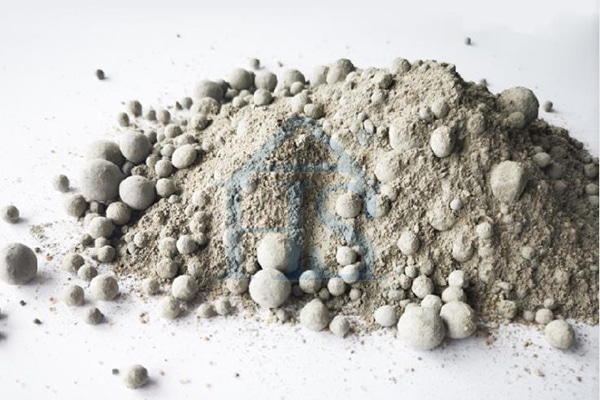Light aggregate concrete is mostly used in highways, bridges and other projects, with a light self-weight, frost and seismic resistance, void ratio, etc. However, in order to improve the fluidity and homogeneity of light aggregate concrete, blended with silica fume and other mineral admixtures has become a more common means, today, I combined with the test method, for you to compile the impact of silica fume on the performance of light aggregate concrete, I hope that can provide some reference for you.
Light-aggregate concrete mixed with silica fume test
Raw materials
- Cement: P-O42.5 cement, density of 3100kg/m³, initial setting time of 115min, final setting time of 186min, 3d flexural strength of 5.3Mpa, 28d flexural strength of 8.8Mpa, 3d compressive strength of 22.3Mpa, 28d compressive strength of 51.7Mpa, standard consistency of 28.5%, fineness 1.8%;
- Coarse aggregate: 5mm~16mm crushed shale ceramic particles, apparent density of 1380kg/m³, bulk density of 780kg/m³, cylinder compressive strength of 6.4Mpa, 1h water absorption rate of 2.65%;
- Fine aggregate: natural river sand, apparent density of 2640kg/m³, bulk density of 1560kg/m³, fineness modulus of 2.5;
- Silica fume: particle size 0.4μm~2.2μm, surface area of 2×104m²/kg;
- Water: tap water;
- Chemical admixture: polycarboxylic acid type high-efficiency water reducing agent.
Test method
According to the standard of mechanical properties of ordinary concrete test method (GB/T50081-2002), ordinary concrete mix performance test method standard (GB/T50080-2016) and other specifications, the work performance and mechanical properties of silica fume light aggregate concrete test, test piece size selected 100mm × 100mm × 100mm 100mm×100mm standard size specimen.
Proportioning design
According to the technical specification of light aggregate concrete (JGJ51-2002), the ratio of concrete is designed, and the baseline ratio of concrete is calculated by the volume method as follows: cement dosage 500kg/m³, fine aggregate 689kg/m³, coarse aggregate 542kg/m³, water consumption 175kg/m³, water reducing agent dosage 0.8% of the mass of cementitious material, silica fume dosage 0.8% of the mass of cementitious material. 0.8%, silica fume admixture of 5%, 10%, 15%, 20%, equal replacement of cement.
The effect of silica fume on the performance of light aggregate concrete
The specimens of light-aggregate concrete were prepared by replacing cement with 5%, 10%, 15% and 20% of silica fume in equal amounts, and then the slump and compressive strength of concrete with different silica fume admixtures were obtained by testing the performance of each concrete specimen in turn.
Effect of silica fume on slump
The reason is that silica fume has good plasticity, and its particles are much smaller than the cementitious material, so it fills in the particles of cementitious material after mixing, which causes the filling water between the particles of cementitious material to be squeezed out and makes the thickness of the water barrier layer increase, thus improving the working performance of concrete mix. silica fume is a kind of admixture with great specific surface area, which requires more water when mixing, so it can cause the slump of concrete to be reduced. It can be seen that the mixing of silica fume can reduce the amount of water percolation of concrete mix, thus improving the consistency and homogeneity of concrete mix.
The effect of silica fume on strength
From the test results, it can be seen that the compressive strength of concrete mixes at different ages is increased after the incorporation of silica fume, in which the compressive strength at 7d and 90d ages increases with the increase of silica fume and then decreases, and the compressive strength of concrete mixes reaches the upper age limit at 10% of silica fume; while the compressive strength at 28d and 60d ages gradually increases with the increase of silica fume. The compressive strengths at 28d and 60d increase gradually with the increase in the admixture of silica fume, and the compressive strengths at 15%-20% of silica fume are basically equivalent.
Due to the large specific surface area of silica fume and fine particles, it can fill in the particles of cementitious materials, which enhances the compactness of concrete mix, and therefore the compressive strength is enhanced; in addition, silica fume can play a good volcanic ash effect at the early stage of hydration, producing a large amount of calcium silicate gel, which enhances the compressive strength of concrete. Therefore, the admixture of silica fume can effectively enhance the workability and mechanical properties of light aggregate concrete, while the compressive strength of concrete with high admixture of silica fume is weaker than that of low admixture in the later stage, so the admixture of silica fume is recommended to be controlled within 10%.
Through the above tests and results, it can be seen that the effect of silica fume on the performance of light aggregate concrete is to reduce the slump and improve the compressive strength, to a certain extent, to improve the workability and mechanical properties of light aggregate concrete for highway use, Henan Superior Abrasives production of high grade silica fume fully meets the requirements of light aggregate concrete admixture, all indicators meet the Henan Superior Abrasives’ high grade silica fume powder is fully compatible with the requirements of light aggregate concrete, and all indicators meet the national standards.





